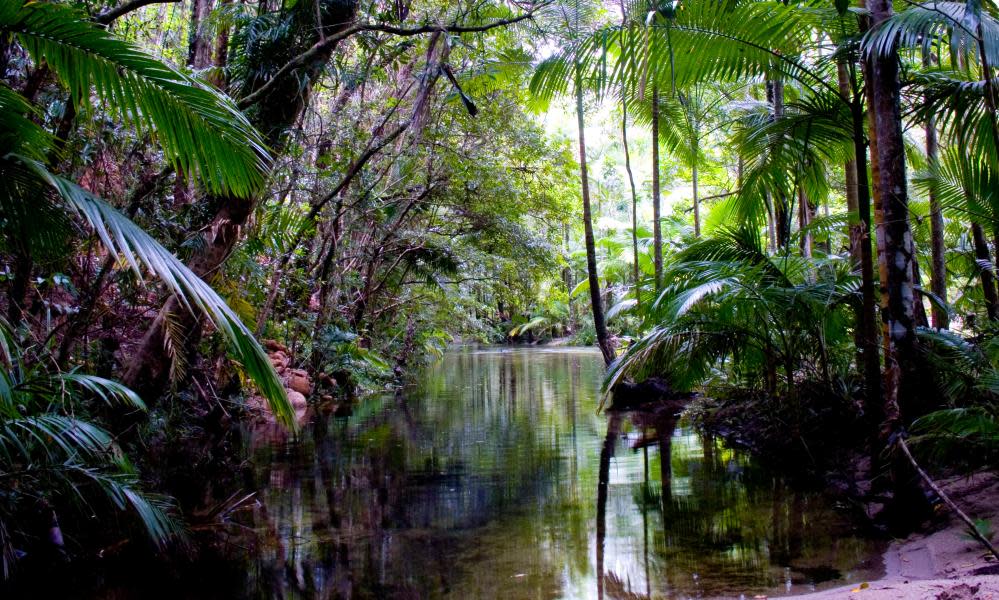Queensland government was warned conservation underfunding 'not sustainable', leak reveals

The Queensland Treasury Corporation warned the state government that its ongoing under-investment in national parks and other protected areas was “not sustainable”, harmed conservation efforts and cost the tourism sector potential visitors worth up to $3.3bn each year.
Guardian Australia has obtained a leaked report from the QTC – the state’s central financing authority – from 2018, calling for a “bold” government strategy and significantly increased funding for protected areas.
The Palaszczuk government promised before the 2017 election to release and implement a strategy “that will establish a world-leading protected area system” in the state.
Three years on, a strategy has not been finalised.
Related: Queensland to enforce hard border closure with NSW and ACT from Saturday
The QTC report warned two years ago that Queensland’s investment in its protected areas was “very modest” compared with other states and territories. At the same time, Queensland was losing its tourism market share to destinations that did spend more protecting their natural environment.
The QTC said that regaining tourist market share already lost to other states could be worth $3.3bn a year to Queensland and create 18,000 new jobs.
“The status quo is not sustainable, and will put Queensland further at risk of lagging behind other states” the report said.
“It is evident that more must be done to protect the state’s natural beauty. Despite pockets of excellence, state-wide biodiversity and conservation outcomes appear to be declining. Fiscal considerations limit what environmental, park and asset management outcomes can be achieved.
“Queensland’s strategy should be a bold and comprehensive step change which will expand the quantity and quality of the protected area estate; provide sufficient funding to maintain and protect the estate; and deliver measurable economic outcomes with greater investment in estate management.”
The state’s target is to establish protected areas on 17% of its land mass – though the QTC report said that a strategy to increase the protected area estate to only 13% of Queensland would cost about $225m in capital funding, and up to $80m a year to properly maintain.
One of the QTC’s recommendations to assist raising the money was to consider entry fees and other charges for visitors at national parks – though such a move is unlikely given the longstanding opposition to such fees by successive Queensland governments.
However, it does highlight the challenge for the state to find an additional stream of funding for its popular natural assets, particularly given the ongoing fiscal challenges that will result from the coronavirus pandemic.
Environmental groups are concerned that, considering the government has not prioritised such an investment during the past term, it could fall further down the priority list during the economic recovery and budget repair process.
Conservationists’ frustration at chronic under-investment and a lack of action to establish new national parks is longstanding.
Andrew Picone, the protected areas program coordinator for the Queensland Conservation Council, said the state’s protected areas strategy had been in draft form since early 2017 and not updated since.
“Protected areas and the whole environment portfolio has never really had the backing of the entire government,” he said.
“There has been some progress made on a range of fronts, particularly for the environment, but protected areas are globally recognised as one of the most effective ways to protect biodiversity. They are essential.
“The status quo in terms of protecting more of Queensland’s diverse ecosystems can’t continue. Ambition must be lifted to match the rhetoric.”
The Queensland Conservation Council points to Griffith University research that estimates national parks worth about $145bn a year to the mental health system.
It says visitors to national parks spent about $3.7bn every year, of which $2.6bn is directly generated by the parks. They support more than 17,000 jobs, mostly in regional Queensland.
“In terms of rebuilding Queensland’s economy and particularly the tourism industry, our biggest asset is our national parks, our beaches, our coastline, the outback, places like Cape York, the Daintree and Lamington,” Picone said.
The state’s environment minister, Leeanne Enoch, said the government would deliver on its commitment to release a protected area strategy.
Related: Inside the bitter struggle for control of Queensland's Liberal National party
“Right now, the government’s focus is on responding to the health and economic crisis of the global Covid-19 pandemic, but our commitment to other issues remains strong.
“We have increased the protected area estate by over 1m hectares since 2015.
“Queensland’s private protected area network is the largest in Australia, and we were the first state to create special wildlife reserves, a new category of protected area that provides national park level protection for private land of exceptional value.”
Encoh said the state was investing $45m to revitalise infrastructure in national parks and another $8.9m for park works and jobs had been announced recently as part of the state’s economic recovery plan.
She said the state’s protected areas strategy would promote land management partnerships with First Nations peoples.
“The strategy will help transform our protected area system and will ensure our most important areas are safeguarded and provide the greatest conservation outcomes for future generations.”

 Yahoo News
Yahoo News 
